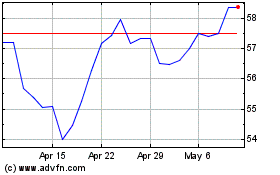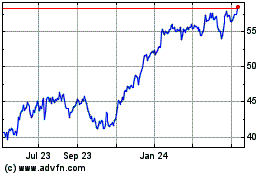By Katy Burne
J.P. Morgan Chase & Co.'s retreat from a mundane but crucial
settlement role in the $13 trillion U.S. Treasury market poses a
fresh challenge for regulators seeking to bolster the market's
capacity to withstand shocks.
The New York bank's decision, announced July 21 and due to be
complete next year, leaves rival Bank of New York Mellon Corp. as
the lone firm handling the settlement of U.S. government debt for
big bond brokers.
Having just one firm in the business of making sure traders
deliver cash and securities as expected will pose a fresh test for
a sprawling market whose functioning has come under scrutiny since
the financial crisis. Many analysts already worry that liquidity,
the capacity to trade quickly without moving prices, has been
falling when markets come under stress.
Following J.P. Morgan's exit, Bank of New York will settle
transactions including the majority of Treasury debt sold at U.S.
government auctions, the majority of Treasurys traded in the
secondary market and most U.S. government debt exchanged in the
overnight "repo" market, a key source of funding in which financial
institutions use the bonds as collateral for cash loans.
Officials at both banks said they had been in touch with the
Federal Reserve and the Treasury Department to reassure them the
moves wouldn't disrupt trading in U.S. Treasurys or the $2.2
trillion daily market for repos. But the move could inflame
concerns that there already weren't enough options for traders,
potentially exposing the market to a shutdown in the event of an
outage at a large settlement firm.
"You have all your eggs in one basket here, and if you're the
Fed, that has to be a little disconcerting, because you don't want
any hiccups in this market," said Ray Stone, a former New York Fed
researcher and head of Stone & McCarthy Research
Associates.
The change, deep in Wall Street's financial plumbing, reflects
pressure from new regulations as well as banks' efforts to cut back
less-lucrative activities.
There were about half a dozen providers of settlement services
in the Treasurys market before consolidation whittled the market
down to two in the 1990s.
But for more than a decade, banks that operate as "primary
dealers" in the Treasury market have only had two options for
settling trades -- Bank of New York and J.P. Morgan.
Bank of New York is prepared to work with dealers that want to
move to its platform and expects to be able to handle the extra
volume, spokeswoman Cheryl Krauss said.
J.P. Morgan said it would continue to provide other related
services, like managing government bonds as collateral for client
trades.
The Treasury is "confident that Treasury securities will
continue to settle and trade in the usual manner," a Treasury
spokesman said.
The Fed and others have been concerned for more than a decade
about Bank of New York's large market share -- now 85% -- for
settlement in a $1.6 trillion part of the repo market.
The central bank worried as far back as 2006 that concentration
could present systemwide risks and considered forming a utility as
a backup, people briefed on the matter said. J.P. Morgan's
announcement may restart those discussions, the people said.
The Fed also is holding Bank of New York to higher operating
standards due to its share of the market.
"A single provider of settlement services -- or a new entrant,
should there be one -- will be expected to operate in a safe and
sound manner that supports market functioning and that is resilient
to stress," said Darren Gersh, a spokesman for the central bank in
Washington.
One concern is damage to infrastructure. The 2001 terror
attacks, for example, hit Bank of New York's telecommunications
lines close to the World Trade Center, causing payment disruptions.
Since 2001, the bank has strengthened and diversified its disaster
recovery procedures, said Ms. Krauss, the bank's spokeswoman.
"If they have a technical glitch, what happens if the collateral
can't be sent back or the money can't be sent? That's wild
business," said Bruce English, who ran the repo desk at Aubrey G.
Lanston & Co., which previously was a primary dealer.
Bank of New York has $29.5 trillion in assets under custody or
administration. It already handles settlement for all but four of
the 23 primary dealers that trade bonds directly with the Fed.
Primary dealers handle the majority of bonds sold in U.S.
government auctions. Most subsequent trades in the market also
involve primary dealers, and settle at either J.P. Morgan or Bank
of New York, although smaller dealers and alternative providers do
exist.
Citigroup clears trades of government securities for clients
such as hedge funds. BMO Harris Bank, a Chicago based unit of BMO
Financial Group with $104 billion in assets under management, is
considering expanding its government securities settlement and
custody services to broker dealers.
"We think there's further opportunity," said Scott Ferris, head
of the financial institutions group at BMO Harris.
Write to Katy Burne at katy.burne@wsj.com
(END) Dow Jones Newswires
July 31, 2016 16:25 ET (20:25 GMT)
Copyright (c) 2016 Dow Jones & Company, Inc.
Bank of New York Mellon (NYSE:BK)
Historical Stock Chart
From Mar 2024 to Apr 2024

Bank of New York Mellon (NYSE:BK)
Historical Stock Chart
From Apr 2023 to Apr 2024
